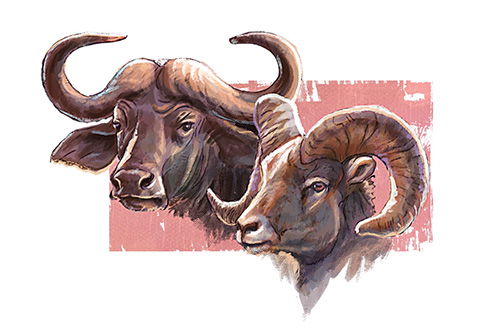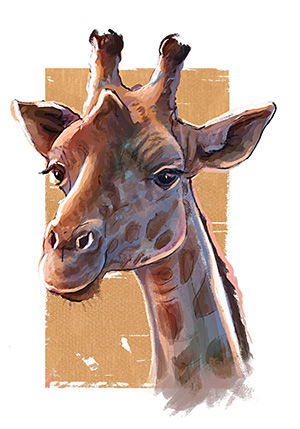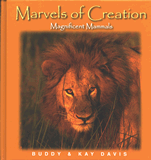Antlers & Horns: Haute Couture Headwear
Horns, antlers, and other headwear are some of the most extravagant features in creation.
This cranial couture serves different functions, such as digging for food, guiding young, scratching itches, and fending off offenders. But the primary purpose? Maintaining the social order in competition for mates and resources—and the “best dressed” get to pass on their genes. Because these adornments aren’t necessarily used for defense or attack, they might have existed in Eden before the fall.
These sharp and showy headpieces—the envy of Louis Vuitton himself—are so over the top in variety and style that they serve as a fashion show put on by the Creator. Let’s check out a few of the most impressive participants in the show.

True horns are unbranched points covered in keratin (the material that makes up hair and nails) with a bony core. Worn by the family Bovidae (goats, cows, bison, and antelope).
The Saber
Ibex, sable antelope, and scimitar-horned oryx boast these dramatic curves resembling Middle Eastern scimitars. Though most of the animals use their horns to stab or lock together, some prefer to thunder down from higher ground with all their weight behind those huge horns.
The Flip Bob
Cape buffaloes and musk oxen pull off this proud part. While this look might seem passé, it goes well with the beasts’ full size. Besides battling for mates, these hefty hulks circle up with horns pointed outward when threatened by predators.

The Crash Test
The spirals worn by bighorn sheep symbolize power. No wonder, since these battling beasts bash with car-crash forces. The sheep’s skull design combined with the horns’ bony core absorbs loads of impact. By boosting blood volume in the brain moments before the crash (basically bubble-wrapping the brain), these sheep are concussion proof.

The Nosehawk
Rhinoceroses combine a majestic, gentle quality with an edgy, heavy machinery look no one wants to mess with. Made of keratin and lacking a bony core, their horns are not true horns. The horns regenerate after being cut, but, sadly, poachers often kill the animals to take their horns. We should seek to steward these animals well so this dashing look doesn’t go out of style.
The Cyclone

This majestic accoutrement is worn by markhor, blackbucks, and addax. Thanks to genetics, each species puts its own spin on the shape and size of the spirals. The ridges often found on these horns result from seasonal growth rate differences due to changing environmental conditions. The spirals and ridges provide better grip during wrestling matches between males.
The Martian
Giraffes and okapi are on point with their ossicones. Neither horns nor antlers, these bony tufts on top of the frontal bone are covered with skin and hair. Though cute, ossicones become weapons when the males swing their heads at each other (called necking) during battles for mates—a real crowd-pleaser.
The Satellite Dish

Antlers are branches built of bone, shed and regrown annually. Worn only by the family Cervidae (deer, elk, and moose).
Although appearing impractical, moose antlers reflect sound to improve hearing. Racks can reach 60 pounds (27 kg) or more, meaning that, during the summer, a bull moose gains about a pound (about 450 g) of antler mass per day. This breakneck growth rate involves processes normally active in bone cancer, so God has given the Cervidae family a suite of cancer-suppressing genes that drastically lower the cancer rate compared to other mammals.

The Indie
Pronghorns throw a wrench into evolutionary storytelling. They don’t fit into Cervidae because their horns have keratin-covered bony cores like bovids, but they also don’t fit into Bovidae because their horns are branched and shed like antlers. Evolutionists say pronghorns evolved independently of these two groups, but the resemblances make more sense if a common Designer made these creatures with similar features.
The Fauxceratops

Jackson’s chameleons channel the trendy triceratops with a classic look of three true horns. After flashing bright colors during a fight, the chameleons change color to reflect either triumph or defeat. They sure know how to add panache to an otherwise drab territorial dispute.

The Arboresque
These stately branched displays are perfect for rough mating competitions in which size makes the difference. During collision, antlers can form microcracks to absorb almost any amount of force. Evolutionists think horns and antlers have a common origin, but their structural, developmental, and genetic data disagree too much to warrant that conclusion.
Answers Magazine
July–September 2022
Recommended Resources

Answers in Genesis is an apologetics ministry, dedicated to helping Christians defend their faith and proclaim the good news of Jesus Christ.
- Customer Service 800.778.3390
- © 2024 Answers in Genesis






